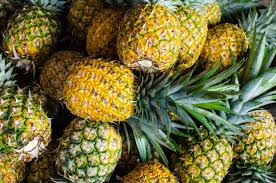Processing, packaging, and exporting pineapples involves several key steps to ensure the fruit arrives at its destination in optimal condition. The process starts with harvesting ripe pineapples, characterized by their golden-yellow color and firm texture.
After harvesting, the pineapples are thoroughly washed to remove any dirt and pesticides. The next step is peeling the skin and removing the hard core, followed by cutting the fruit into uniform pieces, which are then inspected for quality.
Once processed, pineapples are packaged using sturdy materials like corrugated boxes or plastic crates. Care is taken to line the boxes with protective materials and to arrange the pineapples carefully to prevent damage.
Boxes are sealed, labeled, and sometimes equipped with ventilation holes to maintain freshness during transit. Proper storage in a cool place is essential until the pineapples are ready to be shipped.
Exporting pineapples involves several additional considerations. Market research is crucial to identify target markets and understand their requirements. Pricing should reflect production costs and market conditions to ensure profitability.
Establishing reliable buyer relationships, negotiating terms, and complying with export regulations are essential for smooth operations. Efficient logistics and effective marketing strategies also play a significant role in successful pineapple exportation.
How to Process Pineapples for Exportation

1. Harvesting: Choose ripe pineapples that are golden-yellow and firm. Ensure they are fully mature but not overripe, as this affects the quality.
2. Washing: Rinse the pineapples thoroughly with clean water to remove dirt and pesticides. Use a brush for better cleaning, especially around the crown and base.
3. Peeling: Remove the skin by cutting off the top and bottom of the pineapple. Use a sharp knife to peel off the skin in downward strokes, ensuring all eyes are removed.
4. Core Removal: Cut out the hard core from the center of the pineapple. This can be done using a knife or a specialized pineapple corer.
5. Cutting: Slice the pineapple into desired shapes—chunks, rings, or spears—depending on market requirements. Uniform pieces are preferred for better presentation and handling.
6. Quality Check: Inspect the pineapple pieces for defects like browning or mold. Discard any damaged pieces to ensure only high-quality fruit is exported.
7. Packaging: Place the processed pineapple pieces into suitable containers or packaging materials that protect them during transit. Ensure that the packaging is clean and free from contaminants.
8. Cold Storage: Store the packaged pineapples in a cold room or refrigerator to maintain freshness and prevent spoilage until they are ready for export.
9. Documentation: Prepare necessary export documents such as certificates of origin, health certificates, and packing lists. Ensure all paperwork meets the importing country’s regulations.
10. Shipping: Arrange for transportation to the port or airport. Choose a reliable shipping company that handles perishable goods properly to ensure the pineapples arrive in optimal condition.
Read Also: Breed Characteristics of Rabbit
How to Package Pineapples for Exportation

1. Select Packaging Materials: Use sturdy, moisture-resistant packaging materials like corrugated boxes or plastic crates. The materials should be able to withstand handling and transport.
2. Choose the Right Box Size: Select box sizes that fit the pineapple pieces snugly. Avoid overcrowding, as this can cause damage to the fruit.
3. Line the Boxes: Line the inside of the boxes with protective materials such as foam pads or bubble wrap. This cushioning helps to prevent bruising and damage.
4. Arrange Pineapples: Place the pineapples in the boxes carefully. If packaging cut pineapple pieces, layer them with parchment paper or plastic to separate layers and prevent sticking.
5. Seal the Boxes: Close and seal the boxes securely with packing tape. Ensure that the boxes are well-sealed to avoid any exposure to external elements.
6. Label the Boxes: Affix labels on each box indicating the contents, country of origin, and handling instructions. Labels should be clear and comply with export regulations.
7. Add Ventilation: If possible, add ventilation holes to the boxes to allow air circulation. This is crucial for maintaining freshness during long transit.
8. Inspect Packaging: Check that all boxes are properly sealed and labeled. Ensure that there are no signs of damage or weaknesses in the packaging.
9. Store Properly: Keep the packaged pineapples in a cool, dry place until they are ready for shipping. Maintain a consistent temperature to preserve quality.
10. Prepare for Shipping: Organize the boxes for transport. Stack them carefully to avoid crushing and ensure they are ready for loading onto the transport vehicle.
How to Export Pineapples for Profits
1. Market Research: Identify target markets and understand their preferences and regulations for pineapple imports. Research competitors and pricing strategies.
2. Quality Control: Ensure that only high-quality pineapples are processed and packaged. Quality affects pricing and customer satisfaction.
3. Pricing Strategy: Set competitive prices by considering production costs, shipping expenses, and market prices. Ensure your pricing strategy covers all costs and provides a profit margin.
4. Find Buyers: Connect with potential buyers through trade shows, online platforms, or direct outreach. Building relationships with reliable buyers is key to successful exporting.
5. Negotiate Terms: Discuss and agree on payment terms, delivery schedules, and contract conditions with buyers. Clear agreements help in smooth transactions and reducing disputes.
6. Compliance with Regulations: Follow all export regulations, including health and safety standards. Ensure all paperwork and certifications are in order to avoid delays or rejections.
7. Efficient Logistics: Choose a reliable logistics provider to handle shipping and ensure timely delivery. Efficient logistics reduce costs and improve customer satisfaction.
8. Marketing: Promote your pineapples through marketing channels such as social media, online marketplaces, and trade publications. Highlight the quality and unique aspects of your product.
9. Customer Service: Provide excellent customer service by addressing queries and issues promptly. Building a reputation for reliability can lead to repeat business.
10. Monitor and Adjust: Track sales performance and customer feedback. Be prepared to adjust your strategies based on market trends and buyer preferences to stay competitive.
Read Also: Selecting and Improving Desirable Rabbit Traits
Frequently Asked Questions (FAQ’s) About Pineapples

1. How do I know if a pineapple is ripe? A ripe pineapple will have a sweet aroma, a golden-yellow color, and a slight give when pressed. The leaves should be green and fresh.
2. How should pineapples be stored before processing? Store pineapples in a cool, dry place. If they need to be kept for longer periods, refrigerate them to extend freshness.
3. Can I freeze pineapples for export? Yes, pineapples can be frozen. However, freezing may affect their texture. Ensure they are packed in airtight containers to prevent freezer burn.
4. What are the common issues during pineapple exportation? Common issues include spoilage due to improper storage, damage during handling, and delays in shipping. Proper handling and timely shipping can help mitigate these problems.
5. How can I ensure the quality of exported pineapples? Implement strict quality control measures during processing, use proper packaging, and maintain the cold chain throughout transportation.
6. What documentation is required for exporting pineapples? Required documents include certificates of origin, phytosanitary certificates, packing lists, and commercial invoices.
7. How can I find buyers for my pineapples? Attend trade shows, use online marketplaces, network with industry contacts, and reach out to potential buyers directly.
8. What is the best way to handle pineapples during transport? Use cushioned and ventilated packaging, handle with care, and ensure proper temperature control during transport to prevent damage and spoilage.
9. How can I set competitive prices for my pineapples? Research market prices, consider your production and shipping costs, and analyze your competition to set a competitive price that ensures profitability.
10. What are the most common markets for exporting pineapples? Common markets include the United States, Europe, and Asia. Each market has specific preferences and regulations, so tailor your approach accordingly.
Read Also: Strategies for Reducing Waste to Fuel Business

